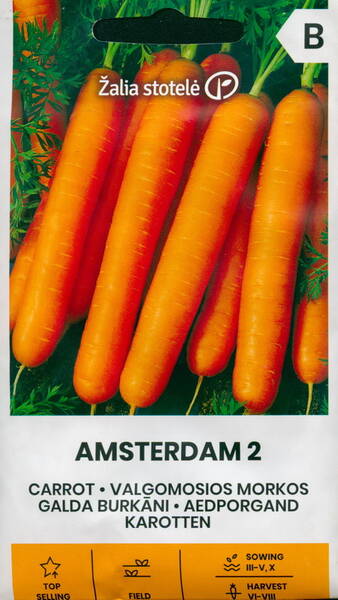Grows best in cultivated, humus, not soaked easy clay loam or sandy loam sols. If the soil is heavy – sprout bad, the root vegetables are short, branchy, split.
An early kind. The crop is harvested 80 days after germination. Root vegetables are cylindrical, 15-17 cm long, tapering with a blunt end.
The core is intangible, the flesh is dark red and juicy. Suitable for fresh consumption and short-term storage.
1,0 g contains approximately 800-1000 seeds.
* Carrots are a common vegetable. It is valued primarily for its high content of provitamin A, vitamin B1, B2, PP and a large amount of minerals.
Like all vegetables, carrots are more useful to us fresh. This crop requires well-drained light soil with sufficient lime, with a deep topsoil.
Carrots do not tolerate direct fertilization with fresh manure, this causes branching and cracking of root crops. Similar signs appear with excessive nitrogen application.
Carrots are very cold-resistant, so they are sown in early spring or before winter. Seeding rate 0.3-0.5 g/m2. Seeding depth 1-2 cm. Row spacing 20-25 cm.
Carrot seeds germinate slowly (at 15-20 days), so it is useful to sow them together with lighthouse crops (mustard, lettuce).
This will allow you to start loosening the soil and removing weeds even before the appearance of carrots, since the formation of a crust on the surface of crops and weeds are harmful to its seedlings.
Shoots are thinned out as early as possible, leaving one plant at a distance of 4-5 cm, and late varieties - 7-10 cm from each other. Immediately after thinning, ammonium nitrate (15 g/m2) and boron-containing fertilizers are applied to the soil.
Fertilizers should not be applied later. In dry weather, crops should be watered. During the period of intensive growth of root crops, watering is limited so that the roots do not crack from excess moisture.
Carrots are divided into early varieties (carotel), medium and late. In carotelia, the root crop is usually shorter and has a blunt end.
These carrots are high in sugar and taste better. Medium and late varieties have long roots, their yield is much higher.
Particularly noteworthy are the ways to combat the carrot fly.
Firstly, these are shifted sowing dates: either winter (in October) or later in spring (end of May).
Secondly, covering crops for a while with non-woven material (such as lutrasil) or perforated film.
Thirdly, the use of seeds on a tape eliminates the need for thinning, namely, when the plants are thinned out, a strong carrot smell appears that attracts a fly.
Fourthly, the use of chemical means of protection (Decis, Karate, Mavrik and other insecticidal preparations based on pyrethroids).












